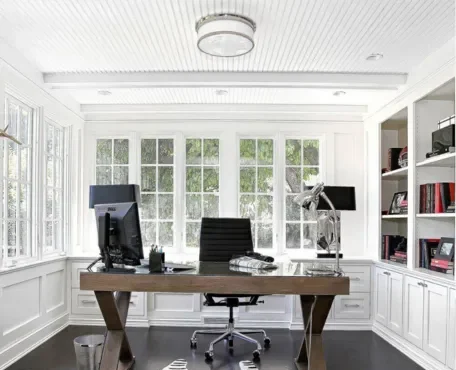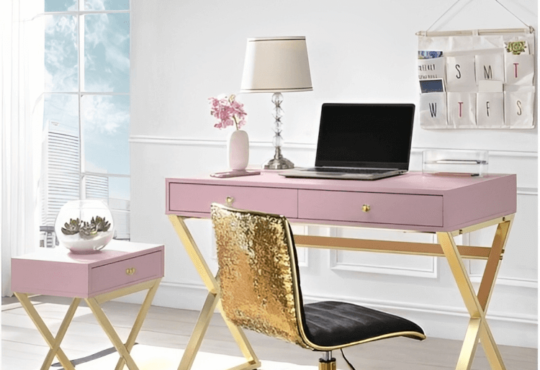
Small office interior design: In the contemporary professional landscape, the design of office spaces holds significant importance. As businesses strive for enhanced productivity, employee well-being, and a competitive edge, the interior design of a small office has emerged as a crucial factor. This essay delves into the intricate world of small office interior design, exploring the key elements, principles, and considerations that contribute to creating an effective, efficient, and aesthetically pleasing workspace.
In the dynamic landscape of small office interior design, the principles of aesthetics, functionality, and employee well-being converge to create spaces that promote productivity, creativity, and a positive work environment. By understanding the significance of each element, adhering to design principles, and considering the unique needs of the company and its employees, small office interiors can be transformed into vibrant, efficient, and inspiring workspaces that contribute to the success of the organization.
I. Understanding the Importance of Small Office Interior Design
A. Impact on Productivity: The design of a small office space has a direct influence on the productivity of employees. A well-designed office layout can facilitate seamless communication, collaboration, and task execution.
B. Employee Well-being: A thoughtfully designed office can contribute to the overall well-being of employees. Factors such as natural light, ergonomic furniture, and proper ventilation contribute to a comfortable and health-promoting environment.
C. First Impressions: The interior design of a small office often forms the first impression that clients, partners, and visitors have of a company. A visually appealing and organized space can convey professionalism and credibility.
2. Key Elements of Small Office Interior Design
A. Space Planning and Layout
- Efficient Use of Space: In a small office, every square foot counts. Effective space planning involves maximizing the use of available space while ensuring smooth circulation and avoiding clutter.
- Zoning: Dividing the office into functional zones, such as workstations, meeting areas, and break spaces, helps in optimizing workflow and creating a sense of purpose for each area.
B. Color and Lighting
- Color Psychology: The choice of colors in a small office can impact the mood and ambiance. Neutral tones and pops of color can create a balanced and stimulating environment.
- Natural and Artificial Lighting: Incorporating natural light through windows and using appropriate artificial lighting not only improves visibility but also affects mood and energy levels.
C. Furniture and Layout
- Ergonomic Furniture: Providing ergonomic chairs, adjustable desks, and proper computer setups promotes comfort and reduces the risk of physical strain and fatigue.
- Flexible Furniture Arrangements: Modular furniture allows for adaptability, enabling the office to evolve based on changing needs.
D. Storage Solutions
- Vertical Storage: In small offices, vertical storage options make efficient use of space and keep surfaces clutter-free.
- Hidden Storage: Furniture with concealed storage compartments helps maintain a clean and organized appearance.
3. Principles of Small Office Interior Design
A. Minimalism
- Less is More: Embracing minimalism prevents overcrowding and fosters a clean, uncluttered workspace.
- Simple Aesthetics: Minimalistic design relies on simplicity, using a limited color palette and streamlined furnishings.
B. Balance and Symmetry
- Visual Balance: Achieving equilibrium in visual elements prevents the space from feeling lopsided.
- Symmetry: Symmetrical arrangements can create a sense of order and visual harmony.
C. Functionality and Flow
- Efficient Workflow: Designing the office layout based on workflow patterns enhances productivity and reduces unnecessary movement.
- Unobstructed Flow: Ensuring unobstructed pathways and clear access to essential areas prevents congestion.
4. Considerations in Small Office Interior Design
A. Branding and Identity
- Consistency with Branding: The office design should align with the company’s brand image and values.
- Personalization: Infusing elements that reflect the company’s culture and identity adds uniqueness.
B. Acoustics and Privacy
- Noise Management: Incorporating acoustic panels and sound-absorbing materials helps control noise levels in open office environments.
- Privacy Solutions: Balancing open spaces with private zones or soundproof meeting rooms caters to varying needs.
C. Technological Integration
- Wiring and Connectivity: Integrating technology seamlessly by providing accessible outlets and proper cable management supports modern office requirements.
- Collaboration Tools: Incorporating technology for virtual meetings and collaborative work enhances connectivity.
5. Trends and Innovations in Small Office Interior Design
A. Biophilic Design
- Nature Integration: Biophilic design involves incorporating natural elements such as plants, water features, and natural materials to connect employees with nature, promoting well-being and reducing stress.
- Health Benefits: Biophilic design has been linked to improved air quality, enhanced cognitive function, and increased creativity among employees.
B. Flexibility and Adaptability
- Agile Workspaces: Modern small offices are embracing flexible layouts that cater to various work styles, enabling employees to choose between collaborative areas, quiet zones, and individual workstations.
- Hot Desking: Implementing hot desking allows employees to choose their workstations daily, fostering interaction among different teams and enhancing dynamic collaboration.
C. Sustainability and Eco-Friendly Design
- Green Materials: Using sustainable and eco-friendly materials, such as recycled wood, low-VOC paints, and energy-efficient lighting, aligns with environmental concerns and promotes a healthier indoor environment.
- Energy Efficiency: Incorporating energy-efficient appliances, smart lighting systems, and solar panels reduces the carbon footprint of the office and lowers operational costs.
6. Case Studies: Successful Small Office Interior Designs
A. Google Workspace Pods
- Innovative Pods: Google’s small office interior designs include modular workspace pods that offer privacy and focus within open-plan offices.
- Collaborative Atmosphere: These pods encourage spontaneous interactions while providing a secluded space for individual work.
B. Etsy’s Sustainable Office
- Reuse and Recycle: Etsy’s Brooklyn office showcases how reclaimed materials and vintage furniture can be used to create a unique and sustainable workspace.
- Biophilic Elements: The office features a living wall and natural materials, creating a connection to nature in an urban environment.
7. Overcoming Challenges in Small Office Interior Design
A. Limited Space
- Smart Storage Solutions: Overcoming space constraints through innovative storage solutions like foldable furniture, under-desk storage, and wall-mounted shelving.
- Multi-Functional Furniture: Investing in furniture that serves multiple purposes can optimize the use of available space.
B. Budget Constraints
- Prioritization: Allocating the budget to key design elements that align with the company’s goals and requirements.
- Cost-Effective Materials: Opting for affordable yet durable materials without compromising on aesthetics.
8. Future Outlook for Small Office Interior Design
A. Hybrid Work Environments
- Flexible Work Models: The rise of remote and hybrid work models calls for office designs that accommodate both in-person collaboration and virtual connectivity.
- Home-Office Integration: Creating spaces that seamlessly blend home and office environments to support remote work when needed.
B. Well-being-Centric Designs
- Mental Health Focus: Future designs may prioritize mental health through features like meditation spaces, relaxation zones, and improved acoustics.
- Health Monitoring: Incorporating technology for monitoring air quality and promoting healthy behaviors among employees.
Conclusion
The realm of small office interior design is a captivating fusion of creativity, functionality, and innovation. By embracing emerging trends, staying attuned to employee needs, and adapting to the evolving work landscape, small office interior design will continue to shape the way we work, collaborate, and thrive. As businesses continue to understand the profound impact of their office environments, the art of small office interior design will remain a dynamic and essential component of organizational success.
Frequently Asked Questions about Small Office Interior Design
Q1: What is the significance of small office interior design?
A1: Small office interior design holds immense importance as it directly influences productivity, employee well-being, and the overall image of a company. A well-designed office space can optimize workflow, enhance creativity, and leave a positive impression on clients and visitors.
Q2: How does interior design impact employee productivity?
A2: Interior design affects productivity by creating a conducive environment for focused work and collaboration. Thoughtful space planning, comfortable furniture, proper lighting, and noise control contribute to reduced stress and improved concentration among employees.
Q3: What role does color play in small office interior design?
A3: Color influences the mood and ambiance of a workspace. Neutral colors promote a calm and professional atmosphere, while pops of vibrant hues can stimulate creativity. Choosing the right color palette can impact the overall energy of the office.
Q4: How can a small office maximize its limited space?
A4: Maximizing limited space involves efficient space planning, modular furniture, and vertical storage solutions. Creating functional zones and avoiding clutter help create an organized and spacious feel even in a small area.
Q5: What is biophilic design, and why is it relevant for small offices?
A5: Biophilic design incorporates natural elements into the workspace, such as plants and natural materials. This design approach improves employee well-being, reduces stress, and enhances air quality—factors crucial for maintaining a positive work environment in small offices.
Q6: How can a small office balance open spaces and privacy needs?
A6: Achieving a balance between open spaces and privacy involves incorporating soundproof meeting rooms, phone booths, and flexible furniture arrangements. These elements allow employees to collaborate while also having spaces for focused work and private conversations.
Q7: What are some cost-effective small office interior design strategies?
A7: Cost-effective strategies include repurposing existing furniture, using affordable yet durable materials, and prioritizing essential design elements that align with the company’s goals. Smart space utilization and creative storage solutions can also help manage costs.
Q8: What does the future hold for small office interior design?
A8: The future of small office interior design involves accommodating hybrid work models, incorporating well-being-focused designs, and integrating technology for seamless collaboration. The blend of in-person and remote work will shape the layout and functionality of office spaces.
Q9: How can technology be integrated into small office interior design?
A9: Integrating technology involves providing accessible outlets, optimizing Wi-Fi connectivity, and incorporating collaboration tools for virtual meetings. Smart lighting systems and environmental monitoring tech can also contribute to a tech-enhanced workspace.
Q10: What are some examples of successful small office interior design implementations?
A10: Examples include Google’s modular workspace pods that balance open and private spaces, and Etsy’s sustainable office that incorporates recycled materials and biophilic elements. These cases showcase innovative approaches to small office design.
Q11: How can a small office design reflect a company’s branding and identity?
A11: Reflecting branding and identity involves using colors, materials, and design elements that align with the company’s values and image. Personalization through artwork, signage, and thematic design elements can also reinforce the brand’s identity.
Q12: What are some challenges faced in small office interior design?
A12: Challenges include space constraints, limited budgets, and the need to balance aesthetics with functionality. Overcoming these challenges requires creative solutions, such as flexible furniture, clever storage, and prioritizing essential design elements.
Q13: How can a small office design promote employee well-being?
A13: Promoting well-being involves incorporating natural light, ergonomic furniture, biophilic elements, and quiet zones. Acoustic management and spaces for relaxation contribute to a healthier and happier work environment.
Q14: What role will sustainability play in future small office interior designs?
A14: Sustainability will play a crucial role, with more offices using eco-friendly materials, energy-efficient appliances, and embracing sustainable practices. The focus on environmental responsibility will drive innovative solutions in design and materials.
Q15: How can small office interior design adapt to the changing work landscape?
A15: Adapting involves creating flexible layouts that accommodate both in-person collaboration and remote work. The design should cater to various work styles and provide seamless technology integration for hybrid work models.






